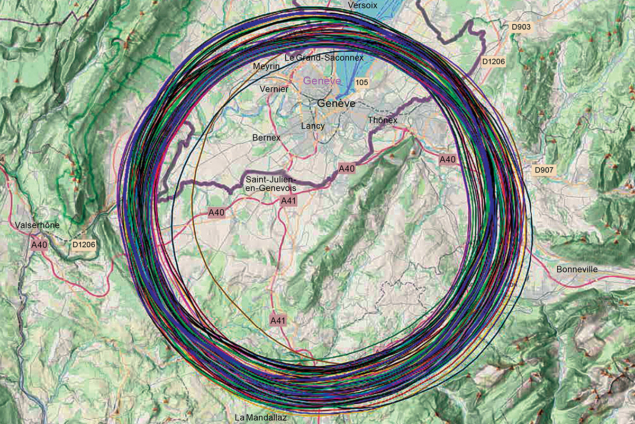An update on the latest progress in optimising the placement of the FCC ring, taking into account scientific output, territorial compatibility and implementation risks.

Designing a next-generation collider with a performance that meets the scientific demands of the particle-physics community is one thing. Ensuring its territorial compatibility, technical feasibility and cost control is quite another. A core element of the FCC feasibility study is therefore the placement of the ring and the necessary surface sites, for which an iterative approach in collaboration with CERN’s host states, France and Switzerland, has been adopted from the outset.
Territorial compatibility requires numerous natural, technical, urban and cultural constraints to be identified and considered. The goal is to limit the consumption of land, keep the quantity of excavated materials to a minimum and re-use as much as possible, minimise the consumption of resources such as electricity and water, avoid visibility, noise and dust nuisances, and create synergies with future neighbours where possible. Following eight years of intense study, one configuration was identified out of some 100 variants as being particularly suitable. This scenario has a circumference of about 90.7 km, eight surface sites and permits the installation of up to four experiments.
During 2023 this reference scenario was reviewed with different regional stakeholders and now serves as the baseline for further design and optimisation activities. These include geophysical and geotechnical investigations to set the optimum depth of the tunnel, links to high voltage grids, access to water for cooling purposes, connections to major rail and road infrastructures, landscape integration and the development of sustainable mitigation measures.
Drill down
Working out how to place a 90.7 km-circumference research infrastructure in a densely populated region requires several dozens of criteria to be met. While initial investigations concerned observations at the square-kilometre level, the focus gradually moved to thousands of square metres and individual land-plot levels. Initial cartographic and database research has progressively been replaced with analysis in the field, working meetings with public administration services and eventually individuals with expert local knowledge. In addition to the scientific and technical requirements, the FCC implementation scenario takes into account the project-implementation risks, cost impacts, access to resources (electricity, water, land), transport requirements, and estimates of the urban and demographic evolution. The study also analyses socio-economic benefits for the region.
The reference layout with only eight surface sites requires less than 50 ha of land use on the surface and constitutes a significant reduction in footprint with respect to the initial scenario drawn up in 2014. All sites are situated close to road infrastructure, with less than 5 km of new roads required, and several of the eight sites are located in the vicinity of 400 kV grid lines. The layout of the FCC is integrated geographically with the existing CERN accelerator complex, with beam transfer possible from either the LHC or via the SPS tunnel.
Throughout all studies, CERN has been accompanied by the services of the Swiss and French authorities at different levels
The feasibility study, carried out with relevant consultancy companies, confirms the technical feasibility of all eight surface sites and the underground works. Working meetings with all the municipalities affected in France and Switzerland have not revealed any showstoppers so far, even if decisions by municipalities and the host states are yet to be taken. Next steps include the detailed integration of the surface sites in the environment.
Timescales are critical to be able to continue with such studies. By the end of the feasibility study in 2025, all land plots that are required by the project need to be communicated to the host states. In addition, a formal environmental evaluation phase in both France and Switzerland is necessary for the authorisation procedures. These activities rely on an agreement between CERN and the host states on the steps to be made by each stakeholder, including the associated legal and regulatory conditions.
Throughout all studies, CERN has been accompanied by the services of the Swiss and French authorities at different levels. This dialogue concerns the more detailed expression of the needs and constraints of the local actors and the identification of potential co-development topics and compensatory measures. The findings are gradually being integrated into a process of project optimisation of the reference scenario to further improve its added value for the territory while keeping the science value high and the project implementation risks low.








